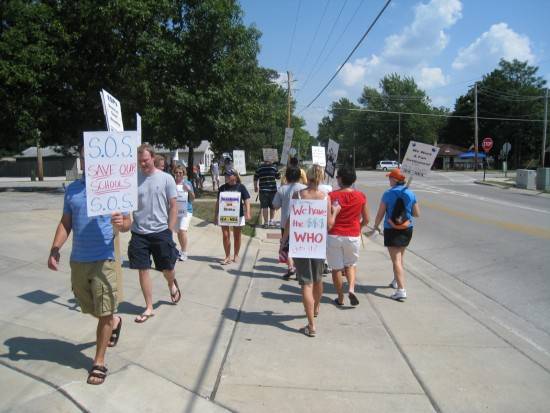
Students and educators in Mahomet were back to class on Monday, Aug. 23 after the Mahomet Seymour Education Association (MSEA) and the school board were able to settle on a new contract on Aug. 20. The settlement marked an end to a two-day strike, the first strike ever in their union’s history.
MSEA secured a one-year contract with 2.6% raise (step + .5%) for teachers, 3.5% (step + 1%) for aides and 3.5% for other support staff. Union president Joan Jordan commented on the two-day strike and the negotiations saying, “I’ve negotiated several contracts and this has been the most contentious process I have ever been through.”
Building Up to ‘The Battle’
The strike was an eruption of continuing disagreement between the union and the district over issues related to employment. Board President Terry Greene had said: “The MSEA president has been quoted as saying ‘[The district school board’s] got the money and the power and we want some of both.’ The board of education has quite a different view.” Although this quote was uttered in the days before the strike, it aptly encapsulated the heart of the struggle between MSEA and the school board prior to the strike.
In the summer of 2009, the Mahomet school board, led by president Terry Greene, had demanded that educational staff perform medical procedures like giving insulin shots and inserting catheters. The board refused to negotiate the issue with MSEA despite significant pressure. Ultimately, the issue went to a mediator who ruled against the union.
With this victory fresh in mind and upcoming contract negotiations looming at the end of the 2009-2010 school year, the board announced in February that fiscal year 2011 would have $643,211 in cuts, including some staff that would be released. The district blamed the economic downturn and Illinois’ fiscal nightmare as they spoke about a projected deficit budget. However, the district would not be running a deficit budget. As the union pointed out, the district would not be ‘in the red’ but rather only less ‘in the black.’ Further undercutting the district’s cries of poverty was the fact that all cut staff, except for those on one year contracts anyway, were rehired by the end of March.
Having seen the bogus cuts for what they were, the union became even more adamant in their demands for appropriate and fair compensation as the district had $2.5 million in its general working fund and another $1.5 million in their education fund.
Ultimately, the disagreement between MSEA and the school board was not totally about money. It was, more importantly, about the power dynamic between the workers and the board. Throughout these previous struggles, it appeared that Greene and the district wanted to bust the union’s strength and prove that administration and board run the district.
The Contract
During the early negotiations, the district’s offer was very negative. Union president Joan Jordan said: “[the board offering was] 0% and no vertical or horizontal movement. So, we weren’t going to get any money for experience for being here another year nor were they offering any money if you had gotten more education. And we have to pay for our own education that we need for our credentials and also to get paid more.”
After little to no movement by the board throughout the spring and into the summer, despite good faith negotiations and movement by the union, MSEA called for a strike. The vote to authorize the work stoppage was overwhelmingly supported with a 211-25 vote.
Quickly, the union began organizing. IEA UniServ Director Gene Vanderport elaborated: “Our folks organized themselves to make this strike work…so we’re well organized and that is key.” Many members of the union volunteered for a number of committees to ensure that a potential strike would likely be successful.
The final district offer was a 2.1% raise for teachers, 2.5% for aides and 2.5% for other support staff. Based on this final salary proposal, union members making as little as $16,500 would actually suffer pay cuts due to rising insurance costs. So, this proposal was not tenable.

The Strike Begins
Prior to the last bargaining session prior to the scheduled start of school, the district canceled school until further notice because of a potential strike. Board President Greene and the district unilaterally left the negotiations without even looking at a proposal by the union. MSEA members were visibly upset as Greene went to the media demanding that the union accept the lowest offer seen in that district for years and to make it binding for two years. Some felt that the pre-emptive canceling of school meant that the district was not interested in negotiating but rather in having the union settle for only the board’s proposals.
The board contended that their $1.5 million education fund and $3 million in working cash fund are for ‘rainy days’ for which the largest economic meltdown since the Great Depression does not apply. It was also recently announced that the district can expect nearly $700,000 from the Federal Education Jobs bill which is meant to pay teachers and support professionals. Any of these revenue streams would have allowed the district to settle a fair and equitable contract with the educators.
MSEA hit the ground running with coordinated committees ensuring that picketers were transported, given water and fed. Others worked on producing press releases and speaking to media about the realities of the strike. The union was quite prepared and had a very effective presence. Outside of a few middle fingers or catcalls, the overwhelming reception to the strike was positive. Many honked horns and waved. Some students even joined the rallying workers with signs like ‘Our teachers rock!’
The negotiations at the end of strike day one failed to bring a settlement as Board President Greene and the district unilaterally walked out of negotiations for the second time that week. Many observers noticed the irony of the board demanding a settlement in the press and then walking out of negotiations multiple times.
Day two of the strike continued the successes of the first day. A rally was held prior to the start of negotiations as chanting cries for a fair contract echoed in the air. By 2:30 pm that day, a contract settlement between the sides had been reached.
“It’s a Major Victory”
After negotiating one of the most contentious contracts in her career, MSEA president Joan Jordan stated: “It’s a major victory for us and the victory came in [the school board] understanding that we are a union and we are going to stand up for ourselves and we will do what it takes to get some action out of the school board.”
The union also recognized that the contract was also about more than sick days and money. It was also about the power relationship between the union and board over the conditions of employment. Jordan reflected: “Part of it was personal. The chief negotiator and myself have been active union members our entire careers and [the school board] just wanted to make the rest of the union know that you shouldn’t be following them.”
The struggle of Mahomet educators marks another victory for organized labor and educators within the state of Illinois.
Neil Parthun writes for the Public i and UC-IMC. Much thanks to him for sharing his work with us.








